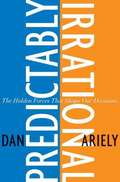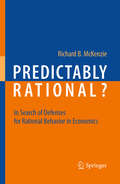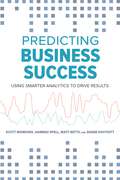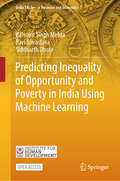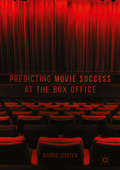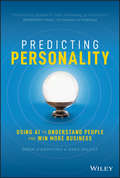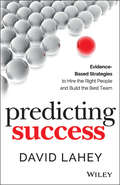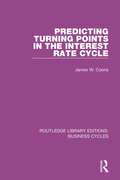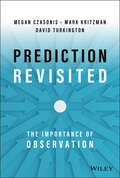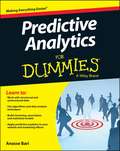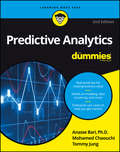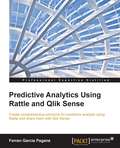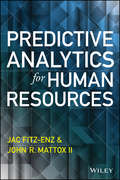- Table View
- List View
Predictably Irrational: The Hidden Forces That Shape Our Decisions
by Dan ArielyWe all think we make smart, rational choices, right? Ariely explains how expectations, emotions, social norms, and other invisible forces skew our reasoning abilities. Not only do we make astonishingly simple mistakes, we make the same types of mistakes. We consistently overpay, underestimate, and procrastinate. We fail to understand the profound effects of our emotions on what we want, and we overvalue what we already own. Yet these misguided behaviors are neither random nor senseless. They're systematic and predictable, making us predictably irrational. Ariely explains how to break through these patterns of thought to make better decisions.
Predictably Rational?
by Richard B. MckenzieMainstream economists everywhere exhibit an "irrational passion for dispassionate rationality." Behavioral economists, and long-time critic of mainstream economics suggests that people in mainstrean economic models "can think like Albert Einstein, store as much memory as IBM's Big Blue, and exercise the will power of Mahatma Gandhi," suggesting that such a view of real world modern homo sapiens is simply wrongheaded. Indeed, Thaler and other behavioral economists and psychology have documented a variety of ways in which real-world people fall far short of mainstream economists' idealized economic actor, perfectly rational homo economicus. Behavioral economist Daniel Ariely has concluded that real-world people not only exhibit an array of decision-making frailties and biases, they are "predictably irrational," a position now shared by so many behavioral economists, psychologists, sociologists, and evolutionary biologists that a defense of the core rationality premise of modedrn economics is demanded.
Predicting Business Success: Using Smarter Analytics to Drive Results
by Matt Betts Shane Douthitt Scott Mondore Hannah SpellHR leaders know people drive business results but often struggle to prove it with data. Predicting Business Success empowers HR professionals to move beyond basic metrics and directly connect talent data to the outcomes executives care about. This practical guide provides a step-by-step approach to scaling analytics organization-wide, making talent profiles predictive and using data to inform key areas such as hiring, onboarding, surveys and training. With actionable strategies for data collection and application, it shows how to embed analytics into everyday decision-making at every level. For HR teams looking to increase influence and drive measurable business impact, this book is an essential roadmap.
Predicting Inequality of Opportunity and Poverty in India Using Machine Learning (India Studies in Business and Economics)
by Balwant Singh Mehta Ravi Srivastava Siddharth DhoteThis open-access book combines traditional economic methods with newer machine learning techniques such as regression trees and random forests to analyse data and provide an in-depth analysis of inequality of opportunity and poverty in India. Using data from national surveys and unique sources like night-time satellite images and location data of points of interest, it explores different aspects of inequality and poverty. The book adopts a unique interdisciplinary approach, blending theories and methods from sociology, economics, geography, anthropology, and computer science to explore three key aspects of human well-being: income, health, and education, focusing on regional disparities. It aims to offer practical insights for policymakers and researchers who want to address social and economic inequalities in India.
Predicting Movie Success at the Box Office
by Barrie GunterThis book explores the different factors that can influence a new movie’s prospects at the box office. Looking at factors such as the production budget, distribution model, genre, stars and audience reactions of films, Gunter asks how such aspects may reduce the uncertainties of success so common in the movie industry. The reader is taken on a journey through filmmaking factors that, research suggests, impact box office performance. While box office revenues represent only part of a movie’s earning potential, Gunter highlights how theatrical performances remain central to what the movie business is about. The chapters illustrate how ticket sales are largely influenced by the production budget but also cultural differences and new movie platforms.
Predicting Personality: Using AI to Understand People and Win More Business
by Drew D'Agostino Greg SklootThe ultimate playbook for using artificial intelligence to communicate effectively, build teams, and win customers Not long ago, we imagined a hyper-connected world full of trust and openness—a world where effortless communication would bring about a new understanding between people everywhere. Judging from our current environment, this vision of the future may have been overly optimistic. With infinite channels and countless voices flooding them with messages, most people have become highly skeptical and guarded by necessity. As a result, communication is much harder than ever before. Despite the unprecedented connectivity enabled by modern technology, we are far less likely to trust and to invest the time needed to build strong relationships. How can we use technology to reverse this trend? A groundbreaking new branch of artificial intelligence—Personality AI—may be the answer. Combining traditional machine learning, data analytics, and behavioral psychology, Personality AI helps professional communicators tear down walls, establish trust with their audiences, and utilize data to build meaningful relationships, strengthen empathy, and win more customers. Predicting Personality is a practical, real-world playbook for any individual or business whose success hinges on the ability to communicate effectively and build teams. Authors Drew D’Agostino and Greg Skloot—CEO and President, respectively, of Crystal, the app that tells you anyone's personality—show you how businesses can leverage Personality AI and machine learning to grow faster and communicate more effectively than was previously possible. This reader-friendly guide teaches you what Personality AI is, how it works, and demonstrates its practical applications in both life and business. This book: ● Explains how to understand personality types in various contexts, including sales, recruiting, coaching ● Provides guidelines for using personality data to learn and execute ● Explores ethics and compliance considerations surrounding the use of Personality AI ● Offers valuable insights from a leader in the business applications of Personality AI Predicting Personality: Using AI to Understand People and Win More Business is a must-have guide for C-suite executives, sales and marketing professionals, coaches, recruiters, and business owners.
Predicting Purchasing Behavior at PriceMart
by Srikant M. Datar Caitlin N. BowlerThis case was written for the EC course “Managing with Data Science.” The course provides MBA students with no programming experience an introduction to the field of data science and its applications in business. Students learn to (1) carefully articulate the business ask; (2) reason carefully from the ask, through metrics and models, and outputs; and (3) evaluate outputs from models to (4) develop a plan for action. This case gets students to grapple with a business “ask” through a data science lens in the context of a large nationwide general retailer. Technical topics include Logistic regression, Ridge & Lasso regression, ROC curve, and picking a cutoff value to optimize a preferred expected value.
Predicting Stock Returns
by David G McMillanThis book provides a comprehensive analysis of asset price movement. It examines different aspects of stock return predictability, the interaction between stock return and dividend growth predictability, the relationship between stocks and bonds, and the resulting implications for asset price movement. By contributing to our understanding of the factors that cause price movement, this book will be of benefit to researchers, practitioners and policy makers alike.
Predicting Success
by David LaheyMake the right hires every time, with an analytical approach to talent Predicting Success is a practical guide to finding the perfect member for your team. <P><P>By applying the principles and tools of human analytics to the workplace, you'll avoid bad culture fits, mismatched skillsets, entitled workers, and other hiring missteps that drain the team of productivity and morale. This book provides guidance toward implementing tools like the Predictive Index®, behavior analytics, hiring assessments, and other practical resources to build your best team and achieve the best outcomes. Written by a human analytics specialist who applies these principles daily, this book is the manager's guide to aligning people with business strategy to find the exact person your team is missing. An avalanche of research describes an evolving business landscape that will soon be populated by workers in jobs that don't fit. This is bad news for both the workers and the companies, as bad hires affect outcomes on the individual and organizational level, and can potentially hinder progress long after the situation has been rectified. Predicting Success is a guide to avoiding that by integrating analytical tools into the hiring process from the start. Hire without the worry of mismatched expectations Apply practical analytics tools to the hiring process Build the right team and avoid disconnected or dissatisfied workers Stop seeing candidates as "chances," and start seeing them as opportunities Analytics has proved to be integral in the finance, tech, marketing, and banking industries, but when applied to talent acquisition, it can build the team that takes the company to the next level. If the future will be full of unhappy workers in underperforming companies, getting out from under that weight ahead of time would confer a major advantage. Predicting Success provides evidence-based strategies that help you find precisely the talent you need.
Predicting Turning Points in the Interest Rate Cycle (Routledge Library Editions: Business Cycles)
by James W. CoonsOriginally published in 1994 and the recipient of the Stonier Library Award, this volume evaluates an alternative approach – the sequential filter- to managing the uncertainty inherent in the future course of the interest rate cycle. The specific hypothesis is that the sequential filter can produce valuable signals of cyclical peaks and troughs in interest rates. The analysis focusses on US interest rates from April 1953 to December 1988.
Predicting the Markets of Tomorrow
by James P. O'ShaughnessyA unique and timely new wealth-building strategy from a legendary investment guru In his national bestsellers How to Retire Rich and What Works on Wall Street, portfolio manager extraordinaire James P. O'Shaughnessy offered investors practical advice based on rigorous quantitative analysis--advice that has consistently beaten the market. But in a recent analysis of market data, O'Shaughnessy uncovered some astonishing trends not discussed in his previous books. The Markets of Tomorrow explains O'Shaughnessy's new research and tells ordinary investors what they must do now to revamp their portfolios. According to O'Shaughnessy, the year 2000 marked the end of a twenty-year cycle that was dominated by the stocks of larger, fastergrowing companies like those in the S&P 500. In the new cycle, the stocks of small and midsize companies are the ones that will outperform the market, along with large company value stocks and intermediate term bonds. O'Shaughnessy describes the number crunching behind his analysis and then shows individual investors exactly how to select the right mix of investments and pick top-performing small and midcap stocks. The Markets of Tomorrow is a loud and clear call to action for every investor who doesn't want to be left behind.
Predicting the Unpredictable
by Johanna Rothman"If you have trouble estimating cost or schedule for your projects, you are not alone. The question is this: who wants the estimate and why?The definition of estimate is to guess. But too often, the people who want estimates want commitments. Instead of a commitment, you can apply practical and pragmatic approaches to developing estimates and then meet your commitments. You can provide your managers with the information they want and that you can live with.Learn how to use different words for your estimates and how to report an estimate that includes uncertainty. Learn who should and should not estimate. Learn how to update your estimate when you know more about your project.Regain estimation sanity. Learn practical and pragmatic ways to estimate schedule or cost for your projects."
Prediction Markets at Google
by Andrew Mcafee Karim R. Lakhani Peter A. ColesIn its eight quarters of operation, Google's internally developed prediction market has delivered accurate and decisive predictions about future events of interest to the company. Google must now determine how to increase participation in the market, and how to best use its predictions.
Prediction Markets: Theory and Applications (Routledge International Studies In Money And Banking Ser. #66)
by Leighton Vaughan WilliamsHow does one effectively aggregate disparate pieces of information that are spread among many different individuals? In other words, how does one best access the ‘wisdom of the crowd’? Prediction markets, which are essentially speculative markets created for the purpose of aggregating information and making predictions, offer the answer to this question. The effective use of these markets has the potential not only to help forecast future events on a national and international level, but also to assist companies, for example, in providing improved estimates of the potential market size for a new product idea or the launch date of new products and services. The markets have already been used to forecast uncertain outcomes ranging from influenza to the spread of infectious diseases, to the demand for hospital services, to the box office success of movies, climate change, vote shares and election outcomes, to the probability of meeting project deadlines. The insights gained also have many potentially valuable applications for public policy more generally. These markets offer substantial promise as a tool of information aggregation as well as forecasting, whether alone or as a supplement to other mechanisms like opinion surveys, group deliberations, panels of experts and focus groups. Moreover, they can be applied at a macroeconomic and microeconomic level to yield information that is valuable for government and commercial policy-makers and which can be used for a number of social purposes. This volume of original readings, contributed by many of the leading experts in the field, marks a significant addition to the base of knowledge about this fascinating subject area. The book should be of interest to anyone looking at monetary economics, economic forecasting and microeconomics.
Prediction Revisited: The Importance of Observation
by Mark P. Kritzman David Turkington Megan CzasonisA thought-provoking and startlingly insightful reworking of the science of prediction In Prediction Revisited: The Importance of Observation, a team of renowned experts in the field of data-driven investing delivers a ground-breaking reassessment of the delicate science of prediction for anyone who relies on data to contemplate the future. The book reveals why standard approaches to prediction based on classical statistics fail to address the complexities of social dynamics, and it provides an alternative method based on the intuitive notion of relevance. The authors describe, both conceptually and with mathematical precision, how relevance plays a central role in forming predictions from observed experience. Moreover, they propose a new and more nuanced measure of a prediction’s reliability. Prediction Revisited also offers: Clarifications of commonly accepted but less commonly understood notions of statistics Insight into the efficacy of traditional prediction models in a variety of fields Colorful biographical sketches of some of the key prediction scientists throughout history Mutually supporting conceptual and mathematical descriptions of the key insights and methods discussed within With its strikingly fresh perspective grounded in scientific rigor, Prediction Revisited is sure to earn its place as an indispensable resource for data scientists, researchers, investors, and anyone else who aspires to predict the future from the data-driven lessons of the past.
Predictive Analytics
by Thomas H. Davenport Eric Siegel"The Freakonomics of big data."--Stein Kretsinger, founding executive of Advertising.com; former lead analyst at Capital OneThis book is easily understood by all readers. Rather than a "how to" for hands-on techies, the book entices lay-readers and experts alike by covering new case studies and the latest state-of-the-art techniques.You have been predicted -- by companies, governments, law enforcement, hospitals, and universities. Their computers say, "I knew you were going to do that!" These institutions are seizing upon the power to predict whether you're going to click, buy, lie, or die.Why? For good reason: predicting human behavior combats financial risk, fortifies healthcare, conquers spam, toughens crime fighting, and boosts sales.How? Prediction is powered by the world's most potent, booming unnatural resource: data. Accumulated in large part as the by-product of routine tasks, data is the unsalted, flavorless residue deposited en masse as organizations churn away. Surprise! This heap of refuse is a gold mine. Big data embodies an extraordinary wealth of experience from which to learn.Predictive analytics unleashes the power of data. With this technology, the computer literally learns from data how to predict the future behavior of individuals. Perfect prediction is not possible, but putting odds on the future -- lifting a bit of the fog off our hazy view of tomorrow -- means pay dirt.In this rich, entertaining primer, former Columbia University professor and Predictive Analytics World founder Eric Siegel reveals the power and perils of prediction:What type of mortgage risk Chase Bank predicted before the recession.Predicting which people will drop out of school, cancel a subscription, or get divorced before they are even aware of it themselves.Why early retirement decreases life expectancy and vegetarians miss fewer flights.Five reasons why organizations predict death, including one health insurance company.How U.S. Bank, European wireless carrier Telenor, and Obama's 2012 campaign calculated the way to most strongly influence each individual.How IBM's Watson computer used predictive modeling to answer questions and beat the human champs on TV's Jeopardy!How companies ascertain untold, private truths -- how Target figures out you're pregnant and Hewlett-Packard deduces you're about to quit your job.How judges and parole boards rely on crime-predicting computers to decide who stays in prison and who goes free.What's predicted by the BBC, Citibank, ConEd, Facebook, Ford, Google, IBM, the IRS, Match.com, MTV, Netflix, Pandora, PayPal, Pfizer, and Wikipedia. A truly omnipresent science, predictive analytics affects everyone, every day. Although largely unseen, it drives millions of decisions, determining whom to call, mail, investigate, incarcerate, set up on a date, or medicate.Predictive analytics transcends human perception. This book's final chapter answers the riddle: What often happens to you that cannot be witnessed, and that you can't even be sure has happened afterward -- but that can be predicted in advance?Whether you are a consumer of it -- or consumed by it -- get a handle on the power of Predictive Analytics.
Predictive Analytics
by Eric Siegel"Mesmerizing & fascinating..." --The Seattle Post-Intelligencer "The Freakonomics of big data." --Stein Kretsinger, founding executive of Advertising.com Award-winning | Used by over 30 universities | Translated into 9 languages An introduction for everyone. In this rich, fascinating -- surprisingly accessible -- introduction, leading expert Eric Siegel reveals how predictive analytics works, and how it affects everyone every day. Rather than a "how to" for hands-on techies, the book serves lay readers and experts alike by covering new case studies and the latest state-of-the-art techniques. Prediction is booming. It reinvents industries and runs the world. Companies, governments, law enforcement, hospitals, and universities are seizing upon the power. These institutions predict whether you're going to click, buy, lie, or die. Why? For good reason: predicting human behavior combats risk, boosts sales, fortifies healthcare, streamlines manufacturing, conquers spam, optimizes social networks, toughens crime fighting, and wins elections. How? Prediction is powered by the world's most potent, flourishing unnatural resource: data. Accumulated in large part as the by-product of routine tasks, data is the unsalted, flavorless residue deposited en masse as organizations churn away. Surprise! This heap of refuse is a gold mine. Big data embodies an extraordinary wealth of experience from which to learn. Predictive Analytics unleashes the power of data. With this technology, the computer literally learns from data how to predict the future behavior of individuals. Perfect prediction is not possible, but putting odds on the future drives millions of decisions more effectively, determining whom to call, mail, investigate, incarcerate, set up on a date, or medicate. In this lucid, captivating introduction -- now in its Revised and Updated edition -- former Columbia University professor and Predictive Analytics World founder Eric Siegel reveals the power and perils of prediction: What type of mortgage risk Chase Bank predicted before the recession. Predicting which people will drop out of school, cancel a subscription, or get divorced before they even know it themselves. Why early retirement predicts a shorter life expectancy and vegetarians miss fewer flights. Five reasons why organizations predict death -- including one health insurance company. How U.S. Bank and Obama for America calculated -- and Hillary for America 2016 plans to calculate -- the way to most strongly persuade each individual. Why the NSA wants all your data: machine learning supercomputers to fight terrorism. How IBM's Watson computer used predictive modeling to answer questions and beat the human champs on TV's Jeopardy! How companies ascertain untold, private truths -- how Target figures out you're pregnant and Hewlett-Packard deduces you're about to quit your job. How judges and parole boards rely on crime-predicting computers to decide how long convicts remain in prison. 182 examples from Airbnb, the BBC, Citibank, ConEd, Facebook, Ford, Google, the IRS, LinkedIn, Match.com, MTV, Netflix, PayPal, Pfizer, Spotify, Uber, UPS, Wikipedia, and more. How does predictive analytics work? This jam-packed book satisfies by demystifying the intriguing science under the hood. For future hands-on practitioners pursuing a career in the field, it sets a strong foundation, delivers the prerequisite knowledge, and whets your appetite for more. A truly omnipresent science, predictive analytics constantly affects our daily lives. Whether you
Predictive Analytics For Dummies
by Mohamed Chaouchi Tommy Jung Anasse BariCombine business sense, statistics, and computers in a new and intuitive way, thanks to Big DataPredictive analytics is a branch of data mining that helps predict probabilities and trends. Predictive Analytics For Dummies explores the power of predictive analytics and how you can use it to make valuable predictions for your business, or in fields such as advertising, fraud detection, politics, and others. This practical book does not bog you down with loads of mathematical or scientific theory, but instead helps you quickly see how to use the right algorithms and tools to collect and analyze data and apply it to make predictions.Topics include using structured and unstructured data, building models, creating a predictive analysis roadmap, setting realistic goals, budgeting, and much more.Shows readers how to use Big Data and data mining to discover patterns and make predictions for tech-savvy businessesHelps readers see how to shepherd predictive analytics projects through their companiesExplains just enough of the science and math, but also focuses on practical issues such as protecting project budgets, making good presentations, and moreCovers nuts-and-bolts topics including predictive analytics basics, using structured and unstructured data, data mining, and algorithms and techniques for analyzing dataAlso covers clustering, association, and statistical models; creating a predictive analytics roadmap; and applying predictions to the web, marketing, finance, health care, and elsewherePropose, produce, and protect predictive analytics projects through your company with Predictive Analytics For Dummies.
Predictive Analytics For Dummies
by Mohamed Chaouchi Tommy Jung Dr Anasse BariPredictive Analytics For Dummies, 2e will help the you understand the core of predictive analytics and get started putting it to use with readily available tools to collect and analyze data. You will learn how to incorporate algorithms through discovering data models, identifying similarities and relationships in your data, and how to predict the future through data classification. You will develop a roadmap by preparing your data, creating goals, processing your data, and building a predictive model that will get stakeholder buy-in. The author will also address "soft" issues, including handling people, setting realistic goals, protecting budgets, making useful presentations, and more, to help the reader prepare for shepherding predictive analysis projects through their companies. Coverage will include: Real-world tips for creating business value Common use cases to help you get started Details on modeling, k-means clustering, and more How you can predict the future with classification Information on structuring your data Methods for testing models Hands-on guides to software installation Tips on outlining business goals and approaches
Predictive Analytics Using Rattle and Qlik Sense
by Ferran Garcia PagansIf you are a business analyst who wants to understand how to improve your data analysis and how to apply predictive analytics, then this book is ideal for you. This book assumes you have some basic knowledge of statistics and a spreadsheet editor such as Excel, but knowledge of QlikView is not required.
Predictive Analytics and Generative AI for Data-Driven Marketing Strategies (Artificial Intelligence, Machine Learning, Data Analytics and Automation for Business Management)
by Hemachandran K Raul Villamarin Rodriguez Debdutta Choudhury Jorge A. Wise Revathi TIn providing an in-depth exploration of cutting-edge technologies and how they are used to support data-driven marketing strategies and empower organizations to make the right decisions, Predictive Analytics and Generative AI for Data-Driven Marketing Strategies includes real-world case studies and examples from diverse marketing domains. This book demonstrates how predictive analytics and generative AI have been successfully applied to solve marketing challenges and drive tangible results. This book showcases emerging trends in predictive analytics and generative AI for marketing, and their potential impact on the future of data-driven marketing. This book is meant for professionals and scholars to gather the skills and resources to use predictive analytics and generative AI effectively for marketing strategies.This book: • Examines the different predictive analytics models and algorithms, such as regression analysis, decision trees, and neural networks, and demonstrates how they may be utilized to get insightful conclusions from marketing data.• Includes generative AI techniques, such as generative adversarial networks (GANs) and variational autoencoders (VAEs), showcasing how these techniques can generate synthetic data for marketing insights and decision-making.• Highlights the importance of data-driven marketing choices and illustrates how generative AI and predictive analytics may be quite useful in this context.• Integrates the principles of data science with marketing concepts, offering a cohesive understanding of how predictive analytics and generative AI can power data-driven marketing decisions.• Presents the recent advances in predictive analytics and generative AI and discusses how they can affect the area of data-driven marketing.
Predictive Analytics for Human Resources
by Jac Fitz-Enz John Mattox IICreate and run a human resource analytics project withconfidence For any human resource professional that wants to harness thepower of analytics, this essential resource answers the questions:"Where do I start?" and "What tools are available?" PredictiveAnalytics for Human Resources is designed to answer these andother vital questions. The book explains the basics of everybusiness--the vision, the brand, and the culture, and showshow predictive analytics supports them. The authors put the focuson the fundamentals of predictability and include a framework oflogical questions to help set up an analytic program or project,then follow up by offering a clear explanation of statisticalapplications.Predictive Analytics for Human Resources is a how-toguide filled with practical and targeted advice. The book startswith the basic idea of engaging in predictive analytics and walksthrough case simulations showing statistical examples. In addition,this important resource addresses the topics of internal coaching,mentoring, and sponsoring and includes information on how torecruit a sponsor. In the book, you'll find:A comprehensive guide to developing and implementing a humanresource analytics projectIllustrative examples that show how to go to market, develop aleadership model, and link it to financial targets through causalmodelingExplanations of the ten steps required in building an analyticsfunctionHow to add value through analysis of systems such as staffing,training, and retentionFor anyone who wants to launch an analytics project or programfor HR, this complete guide provides the information andinstruction to get started the right way.
